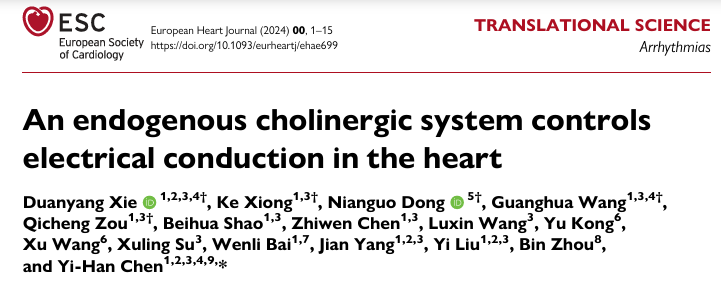查看更多
密码过期或已经不安全,请修改密码
修改密码
壹生身份认证协议书
同意
拒绝

同意
拒绝

同意
不同意并跳过





中国原创临床研究展播第二季活动
医学期刊主编面对面
Global Perspectives, Dialogue with Editors-in-Chief of European Heart Journal
As the Editor-in-Chief of European Heart Journal, you have a unique perspective on transformative trends in cardiovascular science. What key areas of cardiovascular research do you believe will most profoundly reshape the future of cardiology?
作为《欧洲心脏杂志》的主编,您对心血管科学的发展趋势有着独特的见解。您认为,心血管研究中哪些重要领域将重塑心脏病学的未来?

《欧洲心脏杂志》主编Prof. Crea
I think that we have many challenges in front of us. One important challenge is prevention. Traditional risk factors, like diabetes, hypertension, obesity, dyslipidemia, smoking were identified more than 40 years ago. But these traditional risk factors can explain only 50% of cardiovascular disease risk, the remaining 50% is explained by what we call residual risk. And residual risk is mainly related to inflammation and air pollution. I think that we must better characterize cardiovascular risk, including inflammation and air pollution. Current tools are mainly based on traditional risk factors. We must incorporate these new risk factors. And we also need artificial intelligence (AI) to better identify individual risk in the individual patient. Thus, we must include new risk factors and utilize AI in the best possible way. These are two important challenges to address.
我认为我们面临着诸多挑战。其中一个重要挑战是预防。糖尿病、高血压、肥胖、血脂异常、吸烟等传统风险因素早在40多年前就已被确定。但这些传统风险因素只能解释50%的心血管疾病风险,剩余的50%则由我们所称的残余风险来解释。而残余风险主要与炎症和空气污染有关。我认为,我们必须更全面地描述心血管疾病风险,包括炎症和空气污染。目前的风险预测工具主要基于传统风险因素。我们必须将这些新的风险因素纳入考虑。同时,我们还需要利用人工智能(AI)来更好地识别单个患者的个体风险。因此,我们必须纳入新的风险因素,并尽可能最好地利用人工智能。这是我们需要应对的两个重要挑战。
Then another area of development is treatment based on nucleic acids. This is a key development of pharmacotherapy. Nucleic acid-based drugs are the future for the prevention and treatment of cardiovascular diseases. We can utilize different approaches including antisense oligonucleotides, inhibiting RNA and gene editing. All these approaches keep evolving to prevent and treat cardiovascular diseases. One of the advantages offered by nuclei acid-based treatments is that we can treat patients with one injection every six months, rather with a daily administration. And these treatments are very powerful in reducing, for instance, the levels of LDL-C and Lp(a) . And when we come to gene editing, now we have evidence that we can cure cardiac amyloidosis with a single treatment in life. In conclusion, this new potent forms of treatment represent the future in the treatment of cardiovascular diseases.
另一个发展领域是基于核酸的治疗,这是药物疗法的一个重大发展。核酸类药物是预防和治疗心血管疾病的未来方向。我们可以采用不同的方法,包括反义寡核苷酸、RNA抑制和基因编辑。这些方法也都在不断发展以预防和治疗心血管疾病。核酸类治疗的一个优势是可以降低给药频率,例如患者每6个月只需接受一次注射而无需每日给药。这些治疗方法在降低低密度脂蛋白胆固醇(LDL-C)和脂蛋白(a) [Lp(a)]水平等方面非常有效。在基因编辑方面,现有证据表明,1次治疗即可终身治愈心脏淀粉样变性。总之,这些新型强效治疗方法预示着心血管疾病治疗的未来。
Thus, better prevention, new drugs based on nucleic acid, and the third key area of development is artificial intelligence.
所以,更好的预防以及基于核酸的新药研究都是心血管研究未来的关键领域。至于第三个,当然是AI研究。
How do you assess the progress of Chinese cardiovascular research in recent years?
您如何看待近年来中国心血管研究的进展?

《欧洲心脏杂志》主编Prof. Crea
The development of cardiovascular research in China in the past few years has been astonishing. I am proud to say that China is the top submitting country to the European Heart journal. The majority of papers we receive come from China. The improvement of the quantity and quality of Chinese cardiovascular research in the past few years has been really outstanding.
过去几年,中国在心血管研究方面的发展令人惊叹。我可以很自豪地说,中国是向《欧洲心脏杂志》投稿最多的国家。我们收到的大多数论文都来自中国。过去几年,中国在心血管研究的数量和质量上的提升确实非常出色。
Have any research studies from Chinese scholars particularly caught your attention? Could you share an example and explain why it stands out?
有哪些中国学者的研究特别引起了您的注意?您能跟我们举例分享为什么它们会脱颖而出吗?

《欧洲心脏杂志》主编Prof. Crea
I can provide several examples if I had the time, because China has been extremely productive in several areas. For instance, we published a randomized trial, based on Shensong Yangxin, which is a traditional Chinese medicine. This trial shows that it prevents atrial tachyarrhythmia. Thus, we have trials like this, which are extremely innovative, based on traditional medicines.
如果我有时间的话,我可以举出好几个例子,因为中国在多个领域都取得了极为丰硕的成果。比如,我们发表了一项基于参松养心胶囊(一种传统中药)的随机试验。该试验表明,参松养心胶囊可以预防心房快速性心律失常。我们经常有这样一些基于传统药物的极具创新性的试验。
Then we published several contributions in translational science. Recently, we published a study which was the first to show the presence of an endogenous cholinergic system in the heart. And we published a very interesting study on the adaptive immunity in hypertension.
此外,中国学者在转化科学领域也有多项贡献。最近,我们发表了一项研究,首次揭示了心脏中存在内源性胆碱能系统。我们还有一项关于高血压适应性免疫的研究,也很有意思。




We also published elegant epidemiological studies, which are extremely relevant. For instance, we published recently a study showing that low ambient temperature increases the risk of myocardial infarction without stenosis (MINOCA). Epidemiological studies can inspire new approaches to cardiovascular diseases.
同时,我们也发表了一些非常有意义且设计巧妙的流行病学研究。例如,我们最近发表的一项研究表明,低环境温度会增加无梗阻性冠状动脉心肌梗死(MINOCA)的风险。流行病学研究确实能为心血管疾病的防治提供新思路。
Last but not least, we published excellent contributions in the field of AI. We published a paper 5 years ago, very well cited, about prediction of coronary artery disease by AI-assessed facial recognition. This algorithm which assesses facial features predicts the presence of coronary artery disease better than clinical scores. In conclusion, we published many interesting contributions from China in different fields: trials, translational science, epidemiology and also artificial intelligence.
最后但同样重要的是,中国学者在人工智能领域也发表了一些优秀论文。五年前我们发表了一篇目前已经被广泛引用的论文,探讨了基于人工智能和面部识别技术来预测冠状动脉疾病。该算法能通过面部图片预测冠状动脉疾病的发生部位。可以说,中国学者在临床试验、转化科学、流行病学以及人工智能领域都做出了很多贡献。
点击阅读
第二季“中国之声,创新力量——中国原创优秀临床研究展播”活动即将再次起航,敬请期待!
中国医学论坛报杨璐绫 采访撰写
《欧洲心脏杂志》主编Filippo Crea教授审阅
查看更多